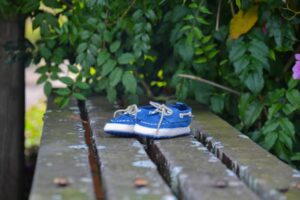Kids are on their feet all day. They need shoes that fit correctly and support their growing feet. Shoes that don’t properly fit can damage their delicate feet and cause lifelong problems. Shop for children’s shoes in a store with employees trained to fit them. Buying shoes for infants, toddlers and young children is complicated.
Here’s our comprehensive kids shoes buying guide to help you get the right pair.
Style
 While shoes might seem like a cosmetic purchase, they can affect kids’ feet and help them develop good balance and alignment. That’s why it’s important to choose quality, on-trend styles that your child will love and feel comfortable in.
While shoes might seem like a cosmetic purchase, they can affect kids’ feet and help them develop good balance and alignment. That’s why it’s important to choose quality, on-trend styles that your child will love and feel comfortable in.
Choose breathable materials. It will keep your child’s feet cooler, drier, and healthier—which can help prevent blisters and other shoe-related discomforts. It’s also a great idea to avoid heels on children’s shoes. Heels can cause problems with proper foot development and are difficult for children to walk in.
Childrens shoes should be shaped to match the shape of a child’s foot and include plenty of room for growth. Babies and toddlers’ nerve endings haven’t developed yet, so they won’t tell you if their feet are squashed or too tight, making it even more important to measure regularly and buy shoes that fit well.
Whenever possible, have your children’s feet professionally measured in-store. Your shoe-fitter will use a small device to measure the length and width of each foot. Remember that it’s normal for feet to be slightly asymmetrical, so the size taken will usually be based on the larger foot. And always shop with socks on, as this will give you a more accurate picture of how the shoes will fit when they’re worn in daily life.
Material
As children grow and develop, so do their feet. They need shoes that will fit properly and allow their feet to breathe. It is recommended that children wear footwear with flexible soles, which help to support the natural movement of the foot. They should also be sturdy and provide traction to prevent slippage.
We always insist in any kids shoes buying guide that it’s best to buy shoes that don’t need a break-in period, as they should be comfortable right away. If the shoes are not comfortable, it is likely that they will be worn incorrectly and may lead to discomfort later on. Shoes that are worn incorrectly can also cause blisters, which can be painful and uncomfortable for kids.
When shopping for kids’ shoes, it is recommended to shop at an actual shoe store where employees are trained to ensure that the child gets the right size shoe. Shoe sizes vary between brands and styles, so a size 3 in one style may be too big or small in another. When measuring for shoes, it is important to do so in the afternoon when feet are naturally swollen.
When purchasing kids’ shoes online, it is important to predetermine the shoe style before heading into the store. This will help to avoid the distractions and other factors that can cause a child to become frustrated or upset when trying on shoes. It is also helpful to purchase shoes that are made with the needs of children’s feet in mind, rather than simply a fashion statement.
Fit
Kids’ feet change quickly, so shoes need to fit well. They shouldn’t be too tight or they could lead to blisters and other foot problems. Look for styles that are rounded in the front and wider at the toes to allow for more room for kids’ feet.
It’s also important to buy shoes that are machine washable, since kids tend to get their shoes dirty often. Other shoe features to consider are breathable materials that help prevent sweaty feet and antimicrobial linings that cut down on odor. And if your kid doesn’t know how to tie their shoes yet, choose a style that slips on so they can wear them without tying them.
Measuring kids’ feet is essential to ensure a good fit. Use our printable kids shoe sizing chart to measure their feet and compare to the sizes on the shoes you’re considering. It’s not uncommon for one foot to be larger than the other, so make sure you always measure both feet.
It’s basic in every kids shoes buying guide to teach you to measure them after they’ve been active because their feet will naturally swell throughout the day. Kids’ feet also grow faster than adults’, so it’s important to check if the shoes still fit regularly. It’s also a good idea to avoid shoes that are too big as kids’ feet may grow into them and cause discomfort later on.